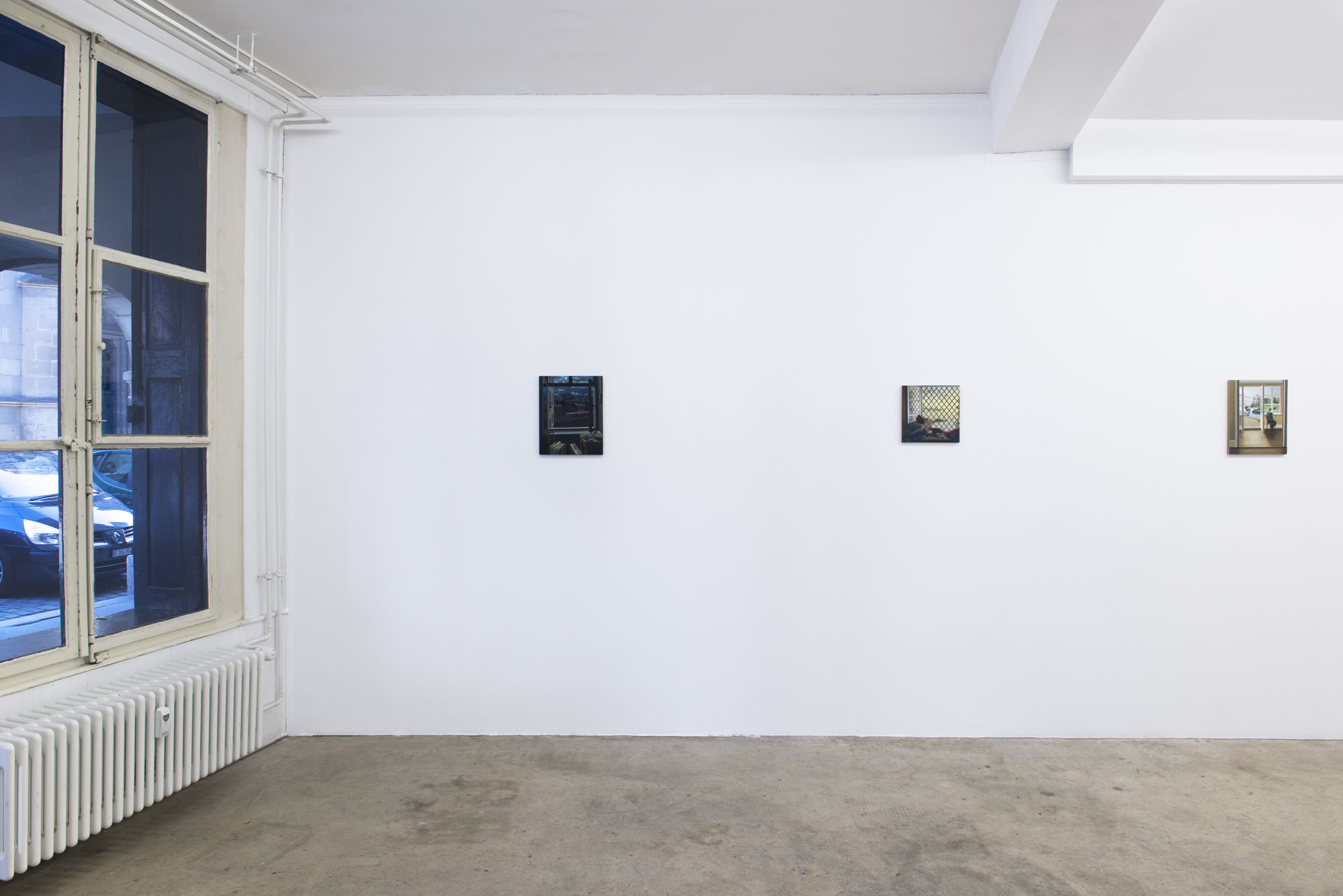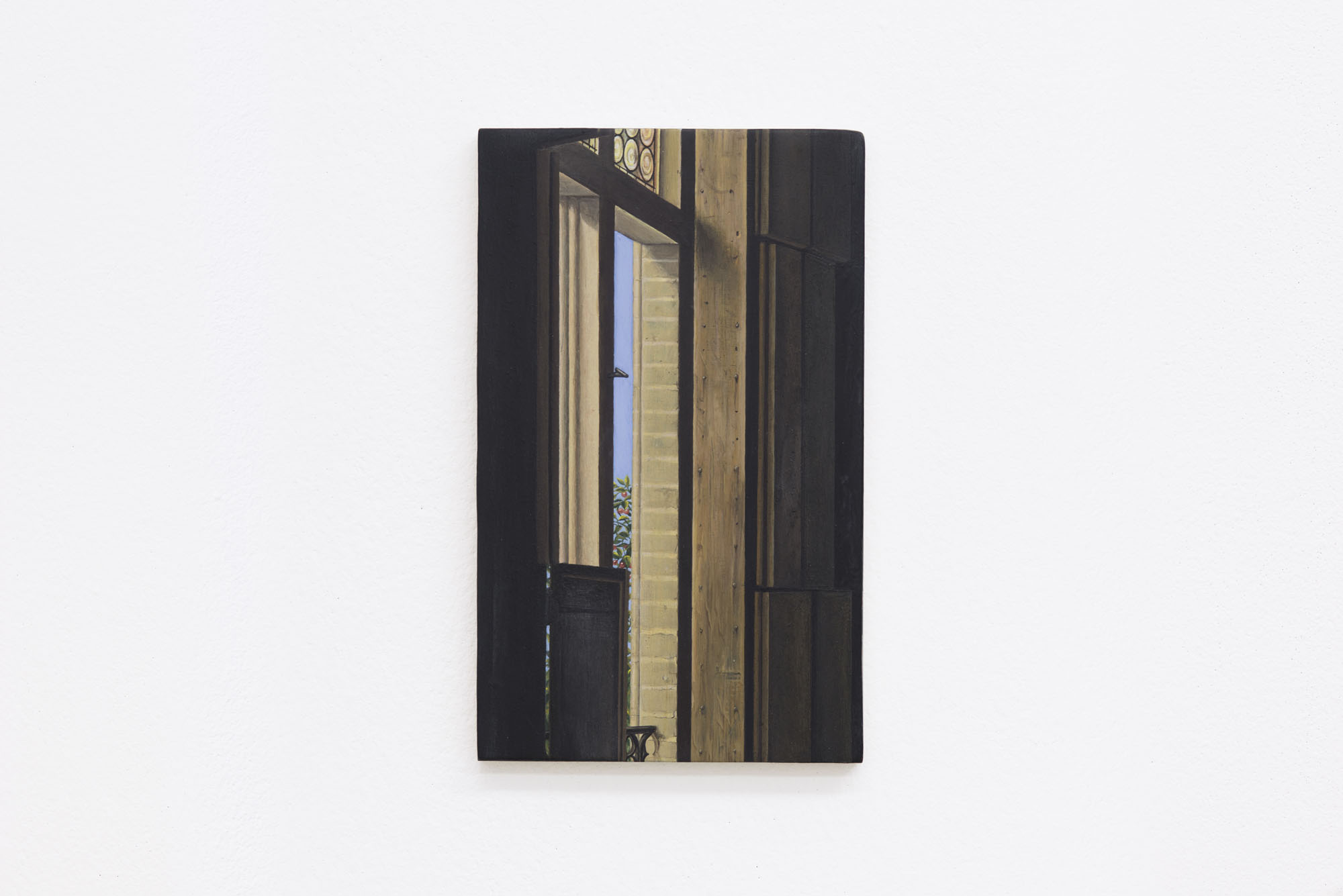Artist: Rita Siegfried
Exhibition title: A Room of One’s Own
Venue: Milieu, Bern, Switzerland
Date: April 28 – June 1, 2019
Photography: all images copyright and courtesy of the artist and Milieu, Bern
Exactly 90 years ago, in ‘A Room of One’s Own’, Virginia Woolf [1] delineated the necessary conditions for the creation of pure poetry. The foundation of her argument was the so-called room of one’s own, meant both as a weighty symbol and as a very concrete place of retreat, where one can think of things in themselves, idle, contemplate the future or the past of the world, dream over books and ‘let the line of thought dip deep into the stream’.[2]
The origin of these ideas can be found in the England of the 1920s. A time of upheaval, when pedestrians, horse-drawn carriages, bicycles and automobiles all share the streets of London. A time when female students at Oxford University finally receive the right to study for the same degrees as their male colleagues – but then, a year later at Cambridge University, in honor of the blocking of this very same policy there, students celebrate by destroying a monument to Anne Jemima Clough [3]. A place –England – where radio waves are transmitted for the very first time, and where the BBC extends its area of coverage to the whole of the British Isles within a mere three years. It is, too, the heyday of the English imperialism: the British Empire encompasses 458 million inhabitants (a quarter of the world’s population at the time), making it the largest empire of all time.
In 1929 Virginia Woolf describes a situation without which the writing of pure poetry is impossible. A situation which can only be achieved when certain basic requirements of space, time and spirit are met. In doing so, she denounces a society that has until then hindered the very existence of female poets:
It is important to have a room of one’s own, which is reserved for oneself alone. It offers the possibility to be oneself, to think of things in themselves, and bars admission to any distraction. It offers time to linger and to become engrossed, without any deadline that may expire.
A social counterpart is needed: a society that is curious about what one has thought. Indifference should not exist, nor should one be greeted by hostility. A community is needed, which prevents a mind from being mislead and from needing to feel resentfulness, protest, anger, bitterness or fear. Only in such conditions can a mind arise that is androgynous, porous and resonant, and is freed from expectations of how it must fit within the social order.
The path to education must be free. There must be a universal basic income of CHF 30,000 per year [4], to guarantee independence and free one from having to work in gray suits for some unknown person or thing.
Woolf gives a hopeful prognosis for the current year: Shakespeare’s sister may well be born – a poet with an androgynous mind, with the same talent and carefree life as her brother, who enjoys the conditions stipulated by Woolf, who has the habit of freedom and the courage to write exactly what she thinks.
The birth of Shakespeare’s sister – and thus of Woolf’s hopes in the possible realization of the social structures she’s called for – is imagined in today’s world. In a time nine years after the Swiss Federal Council first contains a majority of women. In a decade when the Swiss electorate has its first opportunity to vote on a referendum for the Universal Basic Income [5], when the term ‘fake news’ has entered our dictionaries and the Democratic Republic of the Congo holds the last place on the Human Development Index of the United Nations. Her prediction comes in the year of the thirtieth anniversary of the World Wide Web.
In this today, without explicitly referencing Woolf’s texts, Rita Siegried paints spaces which show us the room of one’s own: they remind us of Woolf’s aspirations for the contemporary world. The motifs seem familiar, they seem to show what has already become part of our material reality. And yet Siegried’s works still leave us with a feeling of longing. The moments in which we can linger and become engrossed seem rare; an androgynous, porous and resonant mind turns out to be the exception to the rule. Let us together take the final steps to this goal.
“For masterpieces are not single and solitary births; they are the outcome of many years of thinking in common, of thinking by the body of the people, so that the experience of the mass is behind the single voice.” [6]
Rita Siegfried (*1964) lives and works in Bern. After an apprenticeship as a gilder (1980-1984) she completed her studies in visual arts at the Schule für Gestaltung in Bern in 1999. She presently works as an artist and as a gilder, as well as teaching at the Schule für Gestaltung in Bern. She received the Aeschlimann Corti scholarship in 1996 and ‘Werkbeiträge’ from the city of Bern in 2001.
[1] Virginia Woolf (* 25 January 1882 in London; † 28 March 1941 in Sussex) was a British writer and publisher. She came from an affluent family of intellectuals with contact to numerous literary figures. In her adolescence she experienced first-hand the constraints which Victorian society placed on girls and women. Relatively early in her life she was active as a literary critic and essayist; her career as a novelist began in 1915 with the publication of ‘The Voyage Out’. By the end of the 1920s she had become a successful and internationally recognized author. Woolf was ‘rediscovered’ in the 1970s, when her essay ‘A Room of One’s Own’ (1929) became one of the most frequently cited texts in the nascent women’s movement. Together with Gertrude Stein, her avant-garde works have earned her a place as one of the leading female writers of classic modernism
[2] “By hook or by crook, I hope that you will possess yourselves of money enough to travel and to idle, to contemplate the future or the past of the world, to dream over books and loiter at street corners and let the line of thought dip deep into the stream.” Woolf, Virginia: A Room of One’s Own. Berlin: Insel Verlag 2019 (1929), 127.
[3] Anne Jemima Clough (*1820) was a British suffragette and fought for women’s access to higher education. She was the first principal of Newnham College.
[4] Virginia Woolf gave the sum of £500 per year in 1929, which would be about CHF 30,000 today.
[5] The initiative calls for the implementation of a universal basic income. This would enable the entire population to lead a dignified existence and participate in public life regardless of whether or not they are gainfully employed.
[6] Woolf, Virginia: A Room of One’s Own. Berlin, Insel Verlag 2019 (1929), 79.
Rita Siegfried, A Room of One’s Own, 2019, exhibition view, Milieu, Bern
Rita Siegfried, A Room of One’s Own, 2019, exhibition view, Milieu, Bern
Rita Siegfried, A Room of One’s Own, 2019, exhibition view, Milieu, Bern
Rita Siegfried, A Room of One’s Own, 2019, exhibition view, Milieu, Bern
Rita Siegfried, A Room of One’s Own, 2019, exhibition view, Milieu, Bern
Rita Siegfried, Bahnhof, Acryl on MDF, 36 x 29 cm, 2018
Rita Siegfried, Reiher, Acryl on MDF, 26 x 26 cm, 2019
Rita Siegfried, Kormoran, Acryl on MDF, 34 x 27 cm, 2019
Rita Siegfried, Im Garten, Acryl on MDF, 26 x 26 cm, 2018
Rita Siegfried, Hund, Acryl on MDF, 21 x 26 cm, 2018
Rita Siegfried, Buch, Tempera on MDF, 27 x 17 cm, 2007
Rita Siegfried, Brunnen, Tempera on MDF, 22 x 23 cm, 2006
Rita Siegfried, Steinschlag, Acryl on MDF, 38 x 38 cm, 2014
Rita Siegfried, Haubenmeisen, Acryl on MDF, 40 x 44,5 cm, 2019
Rita Siegfried, Der Maler, Acryl on MDF, 34 x 25 cm, 2018-2019
Rita Siegfried, Goldene Säule, Tempera on MDF, 30 x 28 cm, 2006
Rita Siegfried, Kirschen, Tempera on MDF, 26 x 16 cm, 2004
Rita Siegfried, Wind, Acryl on MDF, 32 x 44 cm, 2015
Rita Siegfried, A Room of One’s Own, 2019, exhibition view, Milieu, Bern



















